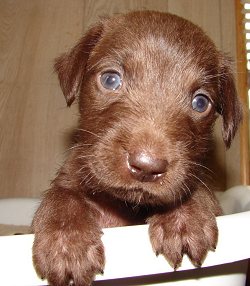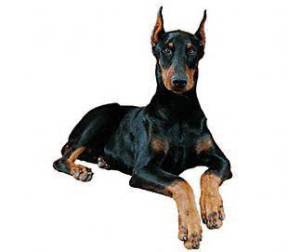Height: 24-28 inches
Weight: 66-88 lbs.
Life Span: 10-12 yrs.
Breed Group: Guardian Dogs
Overview
Dobermans are highly energetic, sensitive dogs that respond well to love
and praise but not to heavy-handed discipline.
Well-socialized Dobermans get along with children and other animals if raised
with them and if treated with respect, but they can be aggressive with other
dogs.
Do not play aggressive games, such as tug-of-war, with Dobermans. While
they are natural guard dogs, some Dobermans are so sweet and submissive
they will let strangers take anything from their homes in exchange for petting
and playtime.
Basic obedience training is mandatory to socialize young Dobermans and enhance
bonding with their owners.
Appearance
The coat is smooth, short, hard, thick, and close-lying. Coat color is black,
black and tan, red, blue, or fawn.
Sharply defined rust markings appear above each eye and on the muzzle, throat,
forechest, all four legs and feet, and below the tail. There may be a gray
undercoat on the neck.
Grooming & Exercise Needs
The Doberman sheds very little and needs only a quick brushing with a rubber
brush once a week.
This highly energetic athlete needs a secure space to run off-leash in rapid
bursts of speed. Walking or jogging is usually not enough.
Origins
The Doberman was originally bred in the late 19th century by Louis Dobermann
of Apolda, Germany. Herr Dobermann was the town's dogcatcher and also a
policeman at night. He wanted to develop a guard dog to accompany him on
his nightly rounds and probably crossed German pinschers, rottweilers, black
and tan terriers, and greyhounds to produce the elegant Doberman.
Special Alerts
It is especially important to obtain a Doberman pinscher from a reputable
breeder, as poorly bred Dobermans may suffer from severe health or aggression
problems. The Doberman is not suitable for inexperienced dog owners.
Breed-related health concerns: cardiomyopathy, cervical vertebral
instability (malformation of the neck vertebrae resulting in a wobbling
gait), hypothyroidism, von Willebrand's disease (a common disorder that
causes excessive bleeding during or after surgery), osteosarcoma, parvovirus,
acral lick dermatitis.
Reference: AKC - American Kennel Club |

